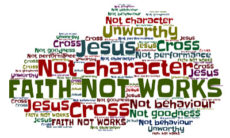One of the popular sayings on some Christian circles is that Jesus was born to die, as though the whole purpose of his being on this earth was to die on that cross, and then be raised back to life.
That is about as realistic as saying that the only purpose for Albert Einstein’s life was developing his theory of relativity. Of course Einstein did a great deal more in his life than that one thing. Likewise Jesus did many other c critical things in his life.
We would be in a very different place if he hadn’t taught the radical lessons that he did, announce the coming of the Kingdom of God as he did, and even take on the religious leaders as he did.
We would never have known he was Son of God is he hadn’t demonstrated the authority of God, as we discussed last week.
The life he lived provided all the clues to the meaning of the death he died, and all of that provided the clues for understanding his being raised back to life by God.
However I think it is fair to say that Jesus’ death on that cross is the defining moment in human history. As we discuss this week, it does fundamentally change our relationship with God and gives us a hope we could never otherwise have.
Some people have gone a bit soft on traditional explanations of what Jesus’ death achieved. The bible actually explains it in a number of ways, not just one. Many believe this shows that even they were seeking good ways to say what they knew to be true that could be understood by the people.
Here are some of those ways of trying to explain it:
- Jesus is the “lamb that was slain.” This image takes the old sacrifice system for the forgiveness of sins and puts Jesus in the place of the sacrifice. In this way he takes our place and atones for our sins.
- The wages of sin is death, and we are all sinners. Therefore we all deserve death (spiritual, not just physical). But Jesus took our place, and because he died for us, we no longer face spiritual death. A typical phrase for this is “he took our place”.
- Closely related to this is the talk of ransom – Jesus paid the ransom price to set you free.
- One variation of this is that the debt is owed to God. You were guilty and under judgment, but the ransom price is paid so you are free from God’s wrath.
- The other is that as a sinner you are under Satan’s reign. A price has to be paid to secure your freedom. In this image, the ransom price is to Satan and you are set free from his power.
- We have been placed into Jesus, and therefore also into his death. Likewise also his resurrection. (especially St Paul.
The above list is not necessarily exhaustive, but it is instructive. All of those explanations speak to a particular worldview – those holding that worldview would be able to relate to that explanation.
It is okay to step back from the explanations and see what they all point to: the death of Jesus somehow deals with our separation from God. In particular it deals with the problem of our sin. How it deals with the problem is not important compared to the critical issue that our sin is dealt with.
However you understand it, the single most central belief in the Christian faith is that the cross of Jesus (often described in terms of his body and blood) delivers us from the power of sin, and opens the way for us to become children of God (“citizens of God’s Kingdom” means exactly the same thing).




